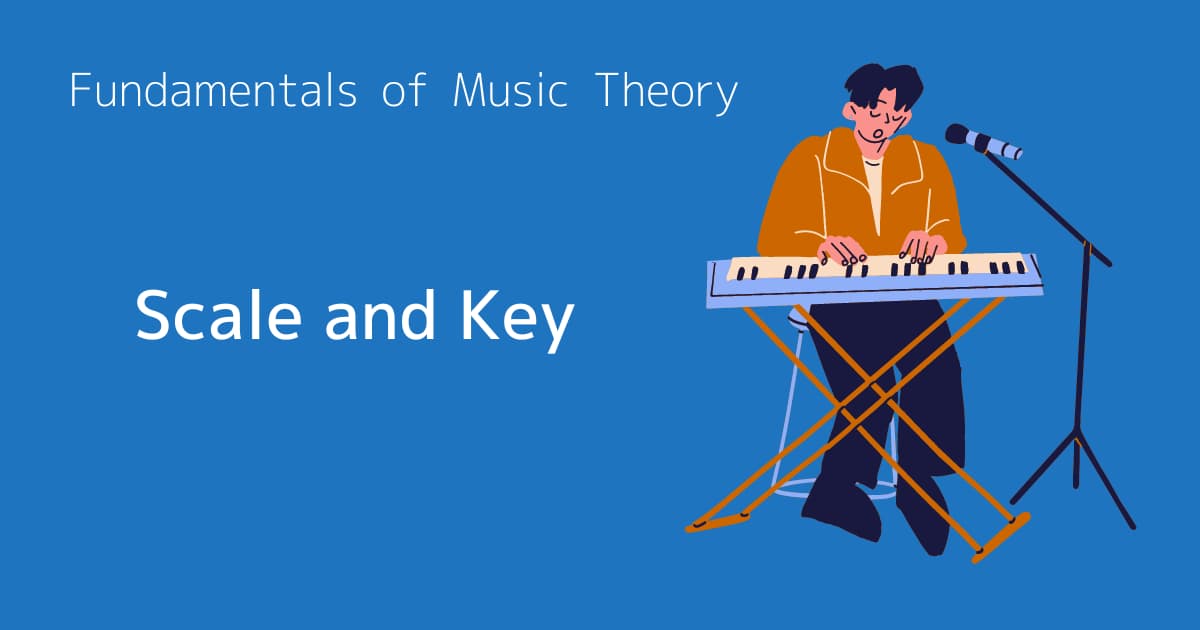This article introduces major scales, natural minor scales, harmonic minor scales, melodic minor scales, and key.
Scales and keys are the foundation of music theory.
There are many scenes that are useful in doing music because it is the foundation.
For example, learning scales and keys makes it easier to compose, copy by ear, and improvise!
In particular, copying by ear is a task that anyone who does music does.
Learning scales and keys will save you valuable time as you will be able to transcribe by ear in less time.
Let’s get started!
Scale
A scale is a set of notes arranged in order of pitch within an octave.
See below for pitch.
Understanding the Differences between Pitch, Interval, and Degree
Scale Type
There are two basic scales:
- Major scale
- Minor scale
There are also several other scales.
Let’s take a look at each.
Major Scale
The major scale is a bright-sounding scale.
A major scaleis a set of tones arranged from the starting point (tonic) of the scale into a whole tone, a whole tone, a semitone, a whole tone, a whole tone, a whole tone, and a semitone.
See below for whole tone and semitone.
Understanding the Differences between Pitch, Interval, and Degree
For example, if C is the tonic, it becomes C, D, E, F, G, A, B, and this is called the C major scale.
| Scale | C | ♭D | D | ♭E | E | F | F# | G | ♭A | A | ♭B | B |
|---|---|---|---|---|---|---|---|---|---|---|---|---|
| C Major Scale | P1 | M2 | M3 | P4 | P5 | M6 | M7 |
See below for degrees.
Understanding the Differences between Pitch, Interval, and Degree
Minor Scale
The minor scale is a dark-sounding scale.
There are three types:
- Natural minor scale
- Harmonic minor scale
- Melodic minor scale
Let’s take a look at each.
Natural Minor Scale
A natural minor scale is a set of tones arranged from the starting point (tonic) of the scale into a whole tone, a semitone, a whole tone, a whole tone, a semitone, a whole tone, and a whole tone.
Also called minor scale.
See below for whole tone and semitone.
Understanding the Differences between Pitch, Interval, and Degree
For example, if A is the tonic, it becomes A, B, C, D, E, F, G, which is called the A natural minor scale.
| Scale | A | ♭B | B | C | ♭D | D | ♭E | E | F | F# | G | ♭A |
|---|---|---|---|---|---|---|---|---|---|---|---|---|
| A Minor Scale | P1 | M2 | m3 | P4 | P5 | m6 | m7 |
See below for degrees.
Understanding the Differences between Pitch, Interval, and Degree
Harmonic Minor Scale
A harmonic minor scale is a scale that raises the 7th of the natural minor scale by a semitone.
| Scale | A | ♭B | B | C | ♭D | D | ♭E | E | F | F# | G | ♭A |
|---|---|---|---|---|---|---|---|---|---|---|---|---|
| A Minor Scale | P1 | M2 | m3 | P4 | P5 | m6 | m7 | |||||
| A Harmonic Minor Scale | P1 | M2 | m3 | P4 | P5 | m6 | M7 |
See below for “degrees” such as 7th.
Understanding the Differences between Pitch, Interval, and Degree
The harmonic minor scale is, as the name suggests, designed to smooth out chord progressions.
Melodic Minor Scale
The melodic minor scale is a scale that raises the 6th of the harmonic minor scale by a semitone.
| スケール | A | ♭B | B | C | ♭D | D | ♭E | E | F | F# | G | ♭A |
|---|---|---|---|---|---|---|---|---|---|---|---|---|
| A Minor Scale | P1 | M2 | m3 | P4 | P5 | m6 | m7 | |||||
| A Harmonic Minor Scale | P1 | M2 | m3 | P4 | P5 | m6 | M7 | |||||
| A Melodic Minor Scale | P1 | M2 | m3 | P4 | P5 | M6 | M7 |
See below for “degrees” such as 6th.
Understanding the Differences between Pitch, Interval, and Degree
The melodic minor scale, as the name suggests, is a scale designed to smooth out the melody of the harmonic minor scale.
Other Scales
In addition to the basic major and minor scales, there are other scales such as:
- Mode Scale
A scale derived from the major and minor scales.
Commonly used in jazz. - Pentatonic Scale
It’s a 5 note scale.
Commonly used in rock and blues. - Symmetrical Scale
It is a regular scale.
Often used in jazz and fusion.
Key
Key refers to which scale a piece of music is based on.
| Key | Scale |
|---|---|
| C Major Key | C Major Scale |
| A Minor Key | A Minor Scale |
Therefore, if the key of the song is decided, the scale that can be used is decided.
For example, if you want to “compose,” “copy by ear,” and “ad-lib” in the C major key, you can choose notes from the C major scale.
Let’s try improvising with the following two types of chord progressions!
You can enjoy the feeling of becoming a person who can make music just by playing the sound of the scale corresponding to the key.
| Chord Progression Example | C→Am→Dm→G |
| Scale | C、D、E、F、G、A、B |
| Chord Progression Example | Am→Dm→G→C |
| Scale | A、B、C、D、E、F、G |


Comments